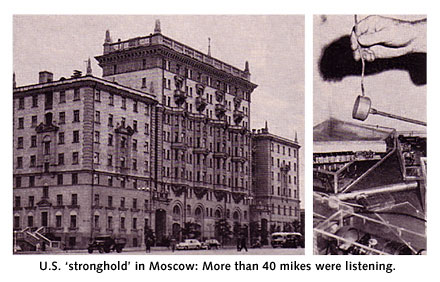The Walls Have Ears
(Newsweek, June 1, 1964)

Twelve years ago this summer Joseph Stalin abruptly ordered the U.S. Embassy in Moscow moved out of the center of town so that he would not have to look at it every time he went in and out of the Kremlin. Not long afterward Stalin died-whereupon the Soviet Foreign Office apologetically called up U.S. officials and told them that the embassy need not move after all. But U.S. security experts, declaring that the new building selected for the embassy was a "dream" from the security point of view, insisted on going through with the move.
Last summer it turned out that what security men thought was a dream had turned into a nightmare. The tip-off came when Premier Nikita S. Khrushchev informed Averell Harriman that he knew U.S. Ambassador Foy Kohler was opposed to West Germany selling the Russians steel pipe. "Don't try to deny it," he told Harriman. "We didn't learn that from our spies." With that, intelligence agents began looking inside the U.S. Embassy's walls. After a series of tests by technicians loaded down with metal-detecting devices, the U.S. Marine guards at the embassy were ordered to tear down the office normally occupied by the embassy's minister counselor, who acts as deputy chief of mission.
 With crowbars and drills the Marines took down the inside walls and carefully carted the debris down to the embassy basement for sifting. After the wrecking operation was completed, Washington revealed last week, more than 40 tiny microphones were found in the debris.
With crowbars and drills the Marines took down the inside walls and carefully carted the debris down to the embassy basement for sifting. After the wrecking operation was completed, Washington revealed last week, more than 40 tiny microphones were found in the debris.
Though the "bugs" had apparently been installed by Russian workmen eleven years ago, when the new embassy was readied for U.S. occupation, many were still in working order. Washington, however, feebly attempted to minimize the security leakage by insisting that the microphones could not have done serious damage since matters of real importance are generally discussed only in "safe rooms" inside the embassy. (A safe room is a room within a room which gives the appearance of being suspended in space. Its walls, ceiling, floor and even supports, are made of transparent plastic so that nothing can be inserted without being discovered.}
Undoubtedly, more safe rooms will now be installed in the Moscow embassy. But the fact that the Soviet wall microphones had survived three ambassadors and eleven years of security tests before being discovered could scarcely fail to arouse among laymen some doubts as to the security experts' assurances that safe rooms are, in fact, safe.
|


